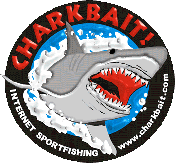|
|
Fishermen's Journal |
A Brief Synopsis of Study
Shark Feeding Study
by Chris Huff
|
The Friday night San Pedro-to-Avalon boat was passing the pilot station headed toward the breakwater when I noticed the little boy seated in front of me, nose pressed to the window, straining to see into the darkness outside. Intrigued by his curiosity, I watched as his mother asked if he was looking for sharks. He nodded that he was. I smiled in anticipation of the conservation lesson I knew Mom was about to deliver to her inquisitive six year old, when she leaned over and said, “Don’t fall in or the sharks will eat you up for a snack.” So much for the conservation lesson.
My colleagues (Ron Moore & Rob Fazio) and I are working on a prey capture behavior study of Blue sharks (Prionace glauca) off the coast of Catalina. The premise is relatively simple: sharks come to the boat, we put food into the water, the sharks eat the food, we videotape the feeding sequences and then use a frame-by-frame VCR to analyze how the shark uses its jaws. Actually, it’s a bit more complicated than that. To be technically correct, we are looking at food capture kinematics (how the shark uses its jaws without consideration for the force applied by the biting movement, which would be mechanics) rather than behavior in an ethological sense, in other words, how the shark uses its jaws rather than how does it behave while feeding, although there is a behavioral aspect to what we’re doing.
Our study is multi-faceted. We hope to find out if the Blue shark modulates or changes how it uses its jaws in response to a variety of scenarios, i.e., large pieces of food items compared to small pieces, taking food items high or low in the water column, taking food items above, below, or to the side of its head, etc. We’ll use different prey items (squid) as well as examine what feeding method or combinations of methods (suction, ram, or bite) are used by blues. You can see how quickly a simple premise becomes complicated.
Of the four days we spent on the water, we found sharks two of those days, both at Avalon Banks, an occurrence that makes good sense if you think like a shark. They tend to be opportunistic feeders and will likely be found near food sources. Anglers go to where the fish are, why wouldn’t sharks?
Once we had a shark at the boat, we continued to chum, waiting to see if it was going to stay. If it stayed, it was time to get in. The sharks wouldn’t tolerate scuba. We tried a couple of times, but they left each time a diver got in with tanks. So the tanks stayed on the boat, and we used weights, masks and snorkels. I could touch the blues from the swim step without having any apparent effect on their behavior, but scuba drove them away. Once the videographer was in place in the water, we put pieces of mackerel in and filmed the feeding sequences for later analysis. Since the sharks won’t take cues from us as to where and how to take the food items, it’s difficult to get all the specific shots you want in one or two sessions in the water. The scarcity of sharks also slows down the process. Quality science, however, is generally not done in a hurry.
The only time we felt it best to get out of the water was when one of the blues began acting in what appeared to be an agitated manner. Side-to-side head snapping and aggressive bites on the swim ladder suggested it was time to dry off. My experience with sharks in the water leads me to believe discretion is always the better part of valor. No ego here.
Reading the shark-related postings to this site, I’m encouraged to see a conservation thread running through them. No need here for me to wade into the abysmal statistics regarding sharks. Attention is being focused on diminishing shark populations. Progress is being made. There is reason to be encouraged. For those of you who have seen sharks in their habitat doing what they have done for millions of years, consider yourself fortunate. Very few people get the chance. Let’s be sure we’re doing what we can to ensure the shark’s place in a healthy, vibrant ocean ecosystem.
Comments, questions, suggestions? Email me at chuff8@sbcglobal.net
|
|
| You too can get published right here at CharkBait. Have an
idea other boaters or fishermen could use, some experience to share, a great trip to
report? Well, get typing, include some pics, and if your article is selected for
publication you'll receive a free CharkChirt and the appreciation of other fishermen.
|




